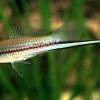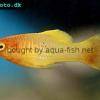Guppy - Poecilia reticulata
Scientific name: Poecilia reticulata
Common name: Guppy
Family: Poeciliidae
Usual size in fish tanks: 4 - 6 cm (1.57 - 2.36 inch)
014
Recommended pH range for the species: 7 - 8
Recommended water hardness (dGH): 12 - 18°N (214.29 - 321.43ppm)
0°C 32°F30°C 86°F
Recommended temperature: 19 - 29 °C (66.2 - 84.2°F)
The way how these fish reproduce: Pseudo-Livebearer
Where the species comes from: South America
Temperament to its own species: peaceful
Temperament toward other fish species: peaceful
Usual place in the tank: Middle levels
Origin
The Guppy (Poecilia reticulata) originally comes from the rivers of South and Central America. In their native habitat, they can be found in both freshwater and brackish rivers. Due to their popularity and adaptability, they have since been introduced to various warm climates around the world, such as Florida in the United States and some rivers in Asia. In some regions, they were deliberately introduced to control mosquito larvae and help decrease malaria occurrences.
Tank Requirements
Guppies are often kept by beginners, but they have specific needs that must be met for them to thrive. A minimum tank size of 40 liters (10.57 US gallons) is recommended for a group of 10 specimens. Small fish bowls without filtration are unsuitable for any fish, including Guppies, as these environments can lead to poor water quality and health issues.
To maintain their health, ensure the water is kept clean, neutral (pH 7-8), and warm, especially during colder seasons. Use a good filtration system to keep water conditions stable. Guppies appreciate tall plants, as these provide hiding spots and create a sense of security. Plants like Vallisneria or Java Fern can be used to provide cover for both adults and fry. Additionally, the aquarium should have moderate water flow and be equipped with a heater to maintain a temperature between 19-29°C (66.2-84.2°F).
Tank Mates
Guppies are social fish that should always be kept in groups of at least 15 to promote natural schooling behavior. When choosing tank mates, consider their active nature; they swim around all day and can annoy slower-moving or long-finned species. Avoid keeping them with fish like Betta fish or slightly aggressive species like Gouramis and Paradise fish, as these species may nip at the Guppies' fins or eat them. It is best to house them with other peaceful fish of similar size, such as Tetras, Corydoras, or other small livebearers.
When keeping Guppies, maintain a ratio of two females per male to prevent the males from harassing the females. If you keep more males than females, the constant pursuit can stress the females, leading to health issues and a shortened lifespan. Without females, males may also become more aggressive towards each other, often nipping at each other's fins during displays.
Feeding
Guppies are not picky eaters and will consume almost anything that fits into their mouths. However, they have small stomachs, so it is important to avoid overfeeding. Feed them small amounts two times a day, or once daily if preferred. Offer foods they can consume within 2-3 minutes to avoid leftover waste and water pollution. Their diet can include high-quality flakes, small granules, and frozen foods like bloodworms, tubifex, and brine shrimp.
Guppies may appear to always be hungry, so it is crucial to monitor their food intake. Providing a balanced diet that includes both plant-based and protein-rich foods will support their overall health and coloration. Additionally, supplements such as vitamins can be added to their diet to promote a strong immune system.
Sexing
Guppy males and females are quite distinct in appearance. Males have smaller, more slender bodies with large, colorful fins that can be as long as their entire body. In contrast, females are larger, bulkier, and less colorful, with shorter fins. Females can be nearly twice the size of males and display more muted coloration, which makes them easier to identify in a mixed group.
Breeding
Guppies are pseudo-livebearers, meaning their eggs are fertilized and hatch inside the female's body. The gestation period lasts about a month, after which the female "gives birth" to live fry. They are prolific breeders and can easily overpopulate an aquarium. A female can store sperm and continue to produce fry for months after mating with a male, so even a single encounter can result in multiple batches of offspring.
Guppies do not require any special conditions for breeding. However, to increase the fry's survival rate, provide plenty of hiding spots using dense plants like Java Fern or Vallisneria. This will give the fry a place to escape from adults, as Guppies, like many fish, may eat their young if given the opportunity. Alternatively, moving a pregnant female to a separate tank with sponge filtration and slow water movement can protect the fry until they are large enough to fend for themselves.
The fry can be fed crushed flakes, granules, or specialized fry food. After about 3 months, they are fully grown and capable of breeding on their own.
Lifespan
The typical lifespan of Guppies is around 2 years. However, with proper care, some individuals may live up to 3 years or more, though this is rare. Inbreeding among commercially bred Guppies often leads to genetic weaknesses, resulting in a shorter lifespan and increased vulnerability to diseases.
Short Description
Guppies are among the most popular aquarium fish due to their vibrant colors and diverse fin shapes. With selective breeding, aquarists can create new color forms and patterns. Some breeders sell only males to maintain the uniqueness of their strains. Despite their beauty, Guppies are hardy and easy to care for, making them an ideal choice for both beginners and experienced aquarists.
Pictures
Thanks a lot to William Yen who has allowed us to use the pictures.
Following pictures were bought by aqua-fish.net from jjphoto.dk















































 Pike
Pike  Biskop-tandkarpe
Biskop-tandkarpe  Mosquito
Mosquito  Twospot
Twospot  South
South  Sailfin
Sailfin  Short
Short  Endler’s
Endler’s  Swordtail
Swordtail  Platy
Platy  Variegated
Variegated